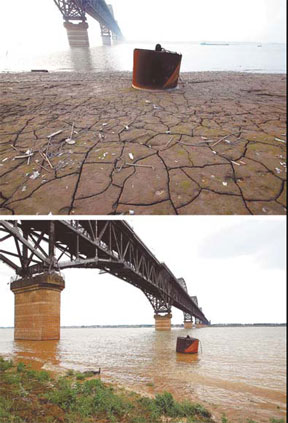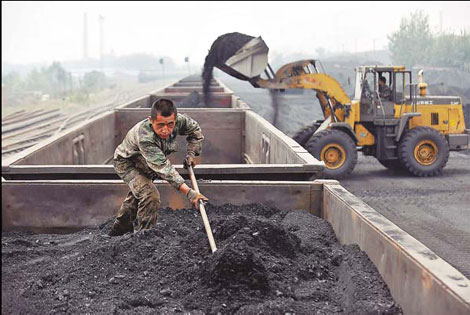Society
Worst drought in 50 years along Yangtze
By Wang Qian (China Daily)
Updated: 2011-05-25 07:45
 |
Large Medium Small |
Dry spell ravages Central China
WUHAN - The worst drought in 50 years to hit provinces along the Yangtze River may continue to plague Central China.
 |
|
A fisherman tries to paddle his boat through a stream amid the partially dried-up Honghu Lake in Honghu city, Central China's Hubei province, on May 20. Zhan Yan / Xinhua |
The China Meteorological Administration warned on Tuesday that little rain is expected in the coming 10 days and highs of 36 C are likely to hit the central and southern parts of China.
These regions will mostly see hot, dry weather during the coming week, the administration said, adding that local departments will activate cloud seeding when weather conditions are fit.
Data indicated that rainfall in these regions is 30 to 80 percent less compared to normal years, while the provinces of Anhui, Jiangsu, Hubei, Hunan, Jiangxi, Zhejiang and Shanghai municipality continue to suffer the worst drought since 1954.
 |
|
This combination of photos shows the water level in the Jiujiang section of the Yangtze River in East China's Jiangxi province has risen from 9.2 meters on May 6 (above) to 10.8 meters on May 23 (below). |
Between January and April, the Yangtze River basin received 40 percent less rainfall than the average level of the past 50 years.
The water area of Dongting Lake in the middle reaches of the Yangtze River was 73 percent less on May 20 than the same day last year, according to statistics from the administration.
As of Monday, the lingering drought in Hubei has affected nearly 10 million people, about one sixth of its population, and influenced 1.2 million hectares of farmland, causing direct economic losses of 7.1 billion yuan ($1.1 billion), according to the provincial civil affairs department.
Since the end of last autumn, most areas of Hubei have received 50 percent less rainfall than the same period in 2010.
The Office of State Flood Control and Drought Relief Headquarters asked the Three Gorges Dam to increase water discharges to up to 12,000 cubic meter per second (about 3,000 cu m per second more than the water flowing in) from May 25 to June 10, in order to raise the water level in the middle and lower reaches.
The water level in more than 1,300 reservoirs in Hubei province have dropped below the allowable discharge level for irrigation, said Yuan Junguang, director of the reservoir management office of Hubei provincial water resources department.
 |
|
A worker at a railway station in Taiyuan, capital of Shanxi province, unloads coal from a cargo train on Tuesday. Railway authorities in the province are accelerating coal transportation to coastal regions that have been facing power shortages partially caused by severe drought. |
"Without adequate water, we lost the spring planting season for rice," said Zhou Xingtao, a farmer in Yandian village.
As the summer planting season approaches, farmers remain uncertain whether the occasionally pumped water will be sufficient.
Everything depends on rain, Zhou said.
With water conservancy facilities unable to provide enough water, farmers must pay high prices for irrigation, and this burden has forced some households to give up on this planting season, Zhou said.
In Hubei's Huanggang city, 3,800 kms of the city's 7,468 kms of irrigation channels are blocked, which means more than half of its farmland can't receive effective irrigation, Mayor Liu Xuerong said.
"It means half of the lifeline of water conservancy facilities for agricultural use is out of function," he said.
In some major grain production regions of Hubei, irrigation facilities were built in the 1950s or 1960s and were not designed to be effective in severe droughts.
Moreover, some public water conservancy facilities were badly damaged or neglected after the community-based management system changed to the household responsibility system in the early 1980s.
The problems of the water conservancy facilities present a significant challenge for Hubei and most regions in Central and South China.
Jiangxi, Hunan, Guangdong, Yunnan and Sichuan provinces and Guangxi Zhuang autonomous region, all located in the south or center of the country, are also suffering from drought and its burdens.
In the counties near Hunan province's Dongting Lake, the second-largest freshwater lake in the country, the drought poses immediate ramifications.
According to Huang Ying, an official in Nanxian county in Hunan, the drought has cost the area its early rice harvest.
Farmers have been forced to move their water pumps to the center of the river, but some parts of the river are dying up quickly, Huang said.
This year's extreme weather combined with extensive cultivation and poor water conservancy has led to the current plight of central and southern regions, water conservancy experts said.
Southern regions enjoy comparatively abundant water resources, and farmers there are used to extensive cultivation without considering techniques for saving water, said Huang Qi, head of the disaster prevention and reduction office of the Yangtze River Water Resources Committee.
A unified water conservancy system is urgently needed, Huang said, while the central government should build large reservoirs and local governments should attend to regional irrigation facilities.
China announced earlier this year it would invest 4 trillion yuan over the next 10 years to establish multi-level water conservancy facilities.
"The modern water conservancy system is key to utilize and allot limited water resources," Huang said.
Xinhua contributed to this story.
| 分享按钮 |